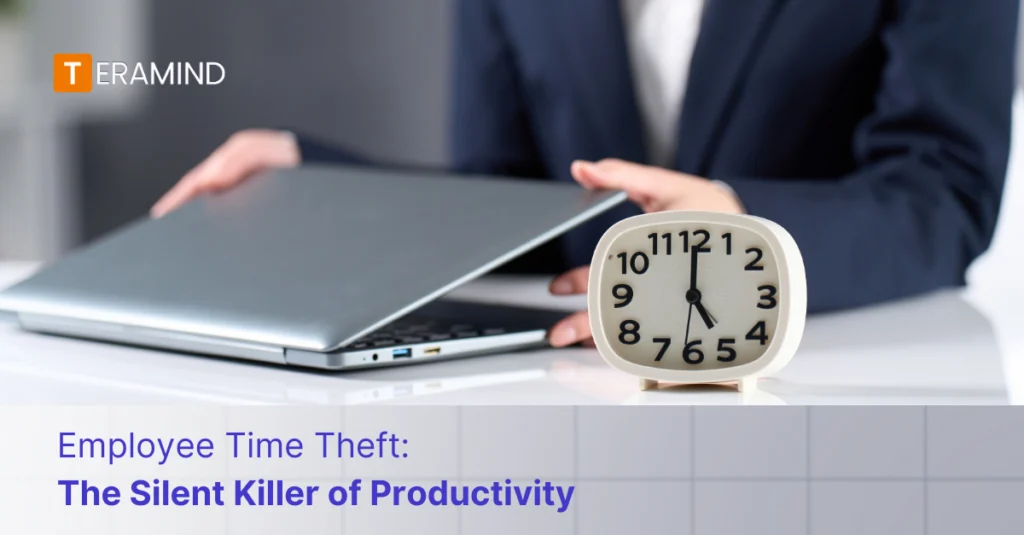Employee time theft is not just a minor issue. It costs US companies a staggering 20% of every dollar earned, equating to a massive $400 billion in lost productivity annually. This financial impact underscores the urgent need to address this silent killer of productivity.
That staggering number highlights the severe impact of unauthorized activities conducted on company time. From extended breaks to digital distractions, time theft erodes productivity, steals profits from business owners, and damages workplace culture. In this article, we’ll explore the various forms of time theft, their consequences, and practical strategies to combat this workplace issue.
What is Time Theft?
Time theft occurs when employees receive compensation for time not productively devoted to their job duties and responsibilities.
It may seem harmless at first glance, but the cumulative effect can be staggering. Time theft encompasses many activities, from minor transgressions like idle time or extended breaks to more severe forms like buddy punching or falsifying timesheets.
These actions deprive the company of valuable work hours while ruining trust and fairness within the organization.
How Employees Commit Time Theft
The different types of time theft can vary greatly, making it challenging to detect and address. Here are some common types of time theft:
Extended Breaks
Many employees stretch their allotted break times, whether for meals, excessive smoke breaks, or personal errands.
While a few extra minutes may seem insignificant, these minor incidents can quickly accumulate, leading to substantial productivity losses. Imagine an employee taking an extra 15 minutes during each lunch break from Monday to Friday – that’s over an hour of lost employee productivity every week!
Timesheet Fraud
Timesheet fraud occurs when employees intentionally falsify their timesheets by reporting hours they did not actually work. This form of theft is widespread among remote or hourly employees, as it can be more challenging to monitor their attendance accurately than that of salaried employees.
Inflating Work Hours
Some employees may arrive late or leave early while still logging a full day’s hours.
This practice, often referred to as “time stealing” or “working the bald clock,” is a form of theft that can be challenging to detect without proper employee monitoring systems, ideally biometric systems. Even a few minutes here and there can add up to significant losses over time and additional hours and labor costs for your business.
Buddy Punching
In this prevalent practice, where 75% of companies lose money to buddy punching, one employee clocks in or out for another, allowing their coworker to get paid for time not worked. This is often done by sharing login credentials or using a colleague’s access card to record their attendance, thereby ‘punching in’ for them.
This practice deprives the company of productive work hours, undermines the integrity of the time-tracking system, and creates an environment of mistrust among colleagues.
Non-work Activities
Employees may engage in personal activities during work hours, such as online shopping, excessive personal calls, or attending to non-work matters like personal emails or social media. While occasional personal activities may be unavoidable, excessive engagement in these pursuits can significantly impact productivity and divert valuable company resources.
Intentional Time Wasting
Some employees may deliberately waste time by procrastinating, socializing excessively, or engaging in other non-productive behaviors.
This form of time theft can be particularly damaging as it steals productive company hours while also setting a negative example for coworkers, potentially spreading a culture of complacency.
Late Arrivals/Early Departures
Employees who consistently arrive late or leave early without accounting for the lost time effectively steal company time.
These minor transgressions may seem harmless, but they can quickly add up and impact the workforce’s productivity and morale.
Digital Distractions
Technology has introduced a new avenue for time theft in the modern workplace. Employees may spend excessive time browsing the web, social media, online shopping, or other online distractions during work hours. While occasional digital breaks may be acceptable, excessive engagement can severely impact productivity and focus.
The pervasive nature of time theft, as evidenced by its various forms, underscores the need for a comprehensive approach to combat it effectively. This approach should include clear policies, effective monitoring, and a positive work culture.
How To Prevent Employee Time Theft
Discouraging time theft requires a multi-faceted approach that combines a clear time theft policy, effective monitoring, and fostering a positive work culture. By implementing the following strategies, businesses can combat time theft and unlock the full potential of their workforce:
Set Clear Goals and Deadlines
Setting clear goals and deadlines is not just a management tool. It’s a crucial strategy in preventing time theft. When employees understand the expected outcomes and timelines, they are more likely to stay focused and productive, reducing the opportunity for time theft.
Monitor Employee Computer Activity
Implement software solutions that track employee computer usage, internet activity, and time spent on specific applications. This data can help identify patterns of time theft and excessive engagement in non-work-related activities. However, it’s crucial to balance monitoring and respecting employee privacy while complying with applicable laws and regulations.
Use a Time Clock
Using a biometric time clock, such as a fingerprint scanner, is a very effective way to prevent buddy punching. Furthermore, time clock software makes it easier to track employee sign-ins more accurately than time cards or paper timesheets, as software carries accurate digital footprints.
Encourage a Positive Work Culture
Foster an environment that values productivity, accountability, and open communication. Happy employees who feel valued and supported are less likely to steal time. Promote a culture of trust, recognition, and work-life balance to cultivate a motivated and engaged workforce with a lower likelihood of time theft.
Provide Adequate Training and Resources
Ensure employees have the necessary training, tools, and resources to perform their jobs effectively.
Lack of proper support can lead to frustration, disengagement, and unproductive behaviors. Invest in continuous skill development and provide the resources needed for employees to succeed in their roles.
Conduct Regular Audits
Review timesheets, employee attendance records, manual timesheets or digital timesheets, and other relevant data regularly to identify potential instances of time theft. Address any discrepancies promptly and consistently. Regular audits help detect issues and serve as a deterrent, reminding employees of the company’s commitment to accountability.
Address Issues Promptly
When instances of time theft are identified, address them swiftly and consistently. Implement disciplinary measures if necessary, but also seek to understand the underlying causes and provide support where appropriate.
Prompt action clearly conveys that time theft will not be tolerated and reinforces the company’s commitment to fairness and productivity.
Lead by Example
Ensure that managers and supervisors model appropriate behavior and do not engage in or encourage time theft themselves. Leadership plays a crucial role in setting the tone and fostering a culture of accountability and integrity within the organization.
Offer Flexible Work Arrangements
Consider offering flexible work options, such as remote work or alternative schedules, to accommodate employee needs while maintaining productivity. Hybrid flexibility can increase job satisfaction, reduce stress, and discourage time theft, as employees feel their needs are being met.
By implementing these strategies and fostering a culture of accountability and respect, businesses can effectively combat time theft and unlock the full potential of their workforce. Remember, addressing time theft is about catching perpetrators and creating an environment that promotes productivity, trust, and a shared commitment to the company’s success.
FAQs
What happens if an employee steals time?
If an employee steals time, the consequences can vary depending on the severity of the offense and company policies. Possible actions may include disciplinary measures, such as warnings, reprimands, or even termination, to ensure accountability and deter future instances of time theft.
What is it called when an employee steals time?
When an employee steals time, it is commonly called time theft or time fraud. Time theft occurs when an employee deliberately manipulates their work hours or engages in activities unrelated to their job while on the clock, resulting in a loss of productivity for the company.
How do you prove time theft?
Employers can use various methods to prove time theft, such as monitoring attendance records, reviewing time logs, and implementing tools like biometric time clocks or timesheet software. Gathering evidence such as surveillance footage or eyewitness accounts can also help substantiate instances of time theft.
How do you confront an employee about time theft?
To confront an employee about time theft, approach the conversation with facts and evidence, and provide specific examples of their behavior that indicate time theft. Maintain a calm and professional demeanor, and give the employee an opportunity to explain their actions before discussing potential consequences or corrective measures.
How to write up an employee for stealing time?
When writing up an employee for stealing time, clearly document the incidents of time theft, including dates, times, and specific actions observed. Meet with the employee to discuss the allegations, present the evidence, and give them an opportunity to provide their side of the story. Take appropriate disciplinary action based on company policies and applicable laws.
How much does time theft cost employers?
According to studies, time theft costs employers billions of dollars annually. The exact amount varies depending on the size of the organization and the extent of the time theft, but it is estimated that time theft can range from 1% to 7% of total payroll expenses.
Conclusion
Employee time theft is a pervasive issue that can have severe consequences for businesses, ranging from lost productivity to decreased profits and a damaged workplace culture. By understanding the various forms of time theft, implementing effective policies and monitoring systems, and fostering a positive work environment, companies can reduce the chance of their employees stealing profits through misused company time.
Remember, a proactive and balanced approach emphasizing accountability, support, and open communication is key to addressing time theft and unleashing your workforce’s full potential. Regularly review and update your strategies, leverage technology where appropriate, and cultivate a culture that values integrity, fairness, and shared success.
Addressing employee time theft is an ongoing challenge, but the rewards of a productive, engaged, and trustworthy workforce make the effort worthwhile. Embrace transparency and lead by example.


